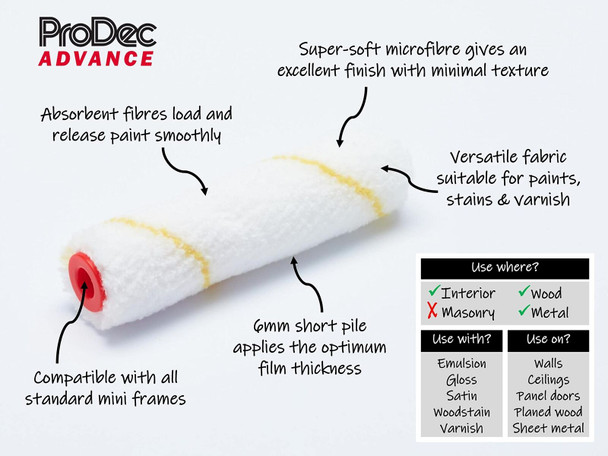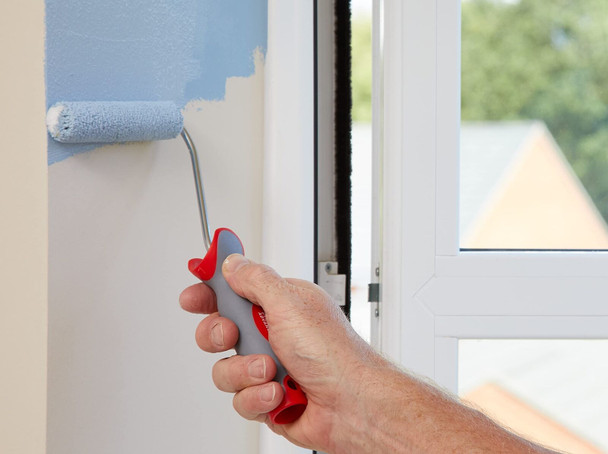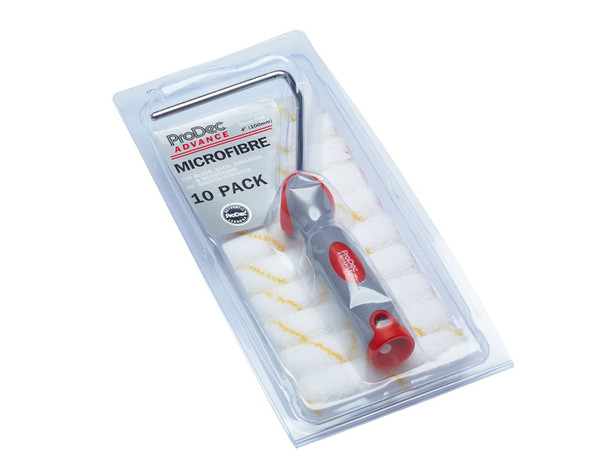Description
ProDec is the UK's biggest and most widely distributed brand of trade decorating accessories, so whether you're a seasoned pro, enthusiastic DIYer or even a beginner, we've got everything you need for a great finish - just add paint
Is this the right roller for me?
Mini rollers are widely used by professionals on wood and metal in preference to brushes as they enable faster, more efficient coverage with no brush marks. Microfibre is the softest roller fabric and will give a very smooth finish. Short pile can be used with more types of paint than any other fabric and is a great choice for skirting board, window sills, wood and metal panels, as well as emulsion paint.
For significant emulsion colour changes a 12mm medium pile is available that will cover better.
For more product information see the bottom section.
What to use and where
PAINTS: Emulsion, Satin, Gloss, Woodstains
SURFACES: Plaster, Drywall, Ceilings (not textured), Smooth planed wood, Metal
PAINTS: Emulsion, Satin, Gloss, Woodstains
SURFACES: Plaster, Drywall, Ceilings (not textured), Smooth planed wood, Metal
PILE DEPTH GUIDE - Selecting the right pile of roller for emulsion or masonry paint is critical to ensuring good coverage and a high quality finish. Use this guide to help you make the right choice.
Short pile
Suitable for smooth and semi-smooth surfaces such as plaster, drywall and ceilings. Because the pile is shorter it puts down less paint and gives you the smoothest of finishes. It's good if you're painting a similar colour over the previous one, but if the colour change is more significant you should consider choosing a medium pile as it will put down more paint and cover better. Short pile rollers can also be used with gloss and satin paints on smooth planed wood and metal.
Medium pile
The most popular pile used with emulsion paints and suitable for smooth and semi-smooth surfaces such as plaster, drywall and ceilings (including light to medium textured plasters such as artex). It is suitable for emulsion colour changes both similar to the previous one and more substantial such as light to dark or vice-versa. Depending on the fabric type, it can also be used on semi-smooth masonry surfaces such as brick.
Long pile
Suitable for semi-rough and rough surfaces such as brick, breeze block, cement and render, where the longer pile is effective at getting into the surface texture, as well as interior walls and ceilings (including medium to heavily textured plasters such as artex). As it lays down plenty of paint it is suitable for colour changes both similar to the previous one and more substantial such as light to dark or vice-versa. Can be used on smooth surfaces but won't give as good a finish as shorter pile rollers.
Extra long pile
Suitable for rough and very rough masonry surfaces such as brick, breeze block, cement, heavily textured renders, stucco (exterior cement plaster) and pebbledash. It gives maximum paint loading - essential for efficiency when painting masonry so you're reloading less often - and is effective at getting into surface textures for rapid application without missing areas.
GETTING THE BEST FROM YOUR PAINT ROLLER - Here are some useful tips that professional decorators use that will save you time and ensure you get the very best result for your hard work.
Before the first use
Unless it is marketed as being lint-free, before its first use wash the roller in cold or tepid water to remove any loose fibres that would otherwise transfer onto the surface when painting: you'll save yourself time not having to pick out bits from the paint film. Remove excess water, stand the roller on its end and allow it to dry fully (ideally overnight) before using.
The first paint load
Allow the first paint load to soak down to the core by leaving it for 5-10 minutes. This will enable the roller to more quickly reach its paint holding capacity and maximise the amount you apply with each load, improving your painting efficiency.
Load the roller evenly
Load the roller with paint and use the roll-off area on your tray or scuttle to distribute paint evenly across and around the roller. This will give even application on the surface and save you time by not having to work out paint that would otherwise be dumped on.
Cleaning after use
Remove as much paint from the roller as you can so as little as possible is wasted or goes into drainage systems. Inexpensive tools specially designed for this are available, or you can use a paint scraper or similar tool. Wash emulsion paints and water-based gloss, satin and woodstains with warm (not hot) water, with a small amount of detergent if it helps. Wash solvent-based paints with white spirit - do not wash white spirit down sinks; use a container and appropriate gloves and dispose of the solvent carefully. Stand the roller on its end and allow it to dry fully (ideally overnight) before using again.
More information on this product
Mini rollers are widely used by trade professionals in preference to brushes when painting flat areas with gloss and satin paints as they enable faster, more efficient coverage. They also have the added advantage of leaving no brush marks, which can sometimes be a problem with some water-based trim paints which are much faster drying than the traditional solvent/oil-based versions.
Microfibre is the most versatile paint roller fabric, with the short pile version being suitable for emulsion paints on walls and ceilings, gloss and satin paints on wood and metal, as well as woodstains and varnishes. The secret to this versatility is the softness - or denier - of the fabric, which gives it a very light touch and means less roller texture in the paint film, also known as mottle with emulsion paints or orange peel with gloss and satin paints, and often seen with other fabrics. Microfibre also works differently to other roller fabrics: it absorbs the paint inside the fibres, instead of the paint just sitting between the fibres, meaning that it both loads more smoothly and releases the paint more evenly throughout the stroke, requiring less working out and increasing your painting efficiency. In practice, you should find that the roller doesn't just dump the paint onto the surface at the start of the stroke, it should release it gradually as you paint.
The 6mm short pile is suitable for interior water- and solvent/oil-based emulsion paints (eg. matt, silk, eggshell), gloss, satin, woodstains and varnishes on smooth and semi-smooth surfaces such as plaster, drywall, ceilings, smooth planed wood and metal. Because the pile is shorter it puts down less paint and gives you the smoothest of finishes - ideal for gloss, satin and woodstains as you don't want to apply too much paint. It's also good for emulsions if you're painting a similar colour over the previous one, but if the colour change is more significant you should consider choosing the 12mm medium pile as it will put down more paint and cover better.
The 10 rollers in this pack are 4” (100mm) width, ideal for painting smaller areas with emulsion that you can't easily get to with a wider roller, and skirting boards, window sills, panel doors, metalwork and more with gloss and satin. For best results the roller should be washed in cold or tepid water before first use to remove any loose fibres. Stand the roller on its end and allow it to dry fully (ideally overnight) before using.
The set is completed with a 26cm long push fit mini roller frame with an ergonomic soft grip handle for comfort, giving reduced hand fatigue during use.




























